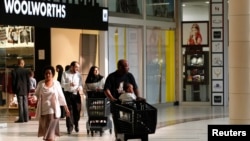DAKAR —
The International Monetary Fund says economic growth in sub-Saharan Africa will pick up to an average of 6 percent in 2014 after a moderate slowdown this year.
In its latest outlook report released for the region in Dakar, the IMF says economic growth in will continue to be "rigorous," reaching as much as 7 percent next year in some of the continent's poorest, mineral-producing countries and averaging 6 percent across the continent.
"Africa rising" has made for an exciting narrative in the past few years, but the surge in growth has yet to improve the daily lives of many Africans.
The Fund's deputy director for Africa, Roger Nord, says poverty is going down but not fast enough.
"If you are in East Africa today versus twenty years ago, the life of the average Rwandan, Tanzanian has changed quite a lot. Has it changed enough? No. We have to remember that Mozambique has grown on average at 8 percent for twenty years. That means per capita GDP went up from 150 to 500. That's still quite poor on average," he said.
Governments, he said, need to address this head-on with measures like targeted subsidies for poor families.
One common assumption is that high global commodity prices have driven Africa's impressive economic growth over the past two decades.
The IMF says that while that has been true for some countries, resources have not been the only ticket to fast growth.
"The countries that have grown the fastest are countries like Tanzania, like Uganda, like Rwanda, Mozambique but also Burkina [Faso] that are quite diversified. They are not the oil exporters or the big mineral exporters that one thinks of, and the answer is because this growth has not come just from exports. It has come from good economic policies that have created a stable macroeconomic situation and have allowed both consumption and investment to rise. That's the kind of growth that is sustained for a long period of time," said Nord.
The IMF says risks for regional growth in 2014 are minimal and are primarily external, like lower global commodity prices or further weakening in emerging markets.
"Twenty years ago, 80 percent of its [sub-Saharan Africa's] trade was with its traditional partners in Europe and the United States," said Nord. "Today, it's less than 50 and the other 50 is with emerging markets in China, in Brazil, in India, but also more trade among each other. It's still low, too low maybe, but it has doubled over the last twenty years. That has given more stability so that diversification is good."
But it also brings risk, he said, and as more African countries begin to seek capital on the international market, Nord cautioned that the debt they take on should be used for investment, like infrastructure, that will fuel more growth.
In its latest outlook report released for the region in Dakar, the IMF says economic growth in will continue to be "rigorous," reaching as much as 7 percent next year in some of the continent's poorest, mineral-producing countries and averaging 6 percent across the continent.
"Africa rising" has made for an exciting narrative in the past few years, but the surge in growth has yet to improve the daily lives of many Africans.
The Fund's deputy director for Africa, Roger Nord, says poverty is going down but not fast enough.
"If you are in East Africa today versus twenty years ago, the life of the average Rwandan, Tanzanian has changed quite a lot. Has it changed enough? No. We have to remember that Mozambique has grown on average at 8 percent for twenty years. That means per capita GDP went up from 150 to 500. That's still quite poor on average," he said.
Governments, he said, need to address this head-on with measures like targeted subsidies for poor families.
One common assumption is that high global commodity prices have driven Africa's impressive economic growth over the past two decades.
The IMF says that while that has been true for some countries, resources have not been the only ticket to fast growth.
"The countries that have grown the fastest are countries like Tanzania, like Uganda, like Rwanda, Mozambique but also Burkina [Faso] that are quite diversified. They are not the oil exporters or the big mineral exporters that one thinks of, and the answer is because this growth has not come just from exports. It has come from good economic policies that have created a stable macroeconomic situation and have allowed both consumption and investment to rise. That's the kind of growth that is sustained for a long period of time," said Nord.
The IMF says risks for regional growth in 2014 are minimal and are primarily external, like lower global commodity prices or further weakening in emerging markets.
"Twenty years ago, 80 percent of its [sub-Saharan Africa's] trade was with its traditional partners in Europe and the United States," said Nord. "Today, it's less than 50 and the other 50 is with emerging markets in China, in Brazil, in India, but also more trade among each other. It's still low, too low maybe, but it has doubled over the last twenty years. That has given more stability so that diversification is good."
But it also brings risk, he said, and as more African countries begin to seek capital on the international market, Nord cautioned that the debt they take on should be used for investment, like infrastructure, that will fuel more growth.
